Homemade Cassava FuFu/Water FuFu – This staple food eaten in many African countries is made from fermented and grounded starchy cassava root may not look like much. It may not look like a whole lot, but don’t let appearances fool you. Its smooth, dense, and chewy texture with a mild taste makes it a great side dish to any protein-rich food, stew, and soup.
If you grew up eating cassava fufu (other aliases are foofoo, foufou, and fufuo, depending on where you grew up), then you’ll be glad to know that you can now make it from scratch using only two ingredients. Oh yes! Sound easy? You bet it is! And it’s healthier and definitely better than the commercially-made ones, especially since we’re not using any preservatives.
Contents…Recipe Ingredients |
What is Cassava Fufu?
I would describe fufu as mashed, pounded cassava root. However, just about any starchy root will do. Even rice, corn, and green plantains or a mix of whatever you have on hand works. Just grind it and cook it with water, stirring vigorously into a thick, smooth consistency. It is thick enough to scoop up soups or stews. Yum!
Recipe Ingredients
Cassava fufu is fermented because fermentation softens the cassava and eliminates any potentially toxic compounds it has when raw. The process also adds a pleasantly light sour flavor to this fantastic starchy root. Think of African sourdough with only two ingredients. Oh yeah!
- Cassava – Also known as yuca (not to be confused with yucca, an ornamental plant), cassava is a traditional ingredient in many African, Caribbean, and Latin American dishes. Just FYI, it’s toxic when eaten raw, so always be sure to cook it. You can also use green plantain, malanga (cocoyam or taro), or any starchy root.
- Water – We need the water for the fermentation process to soften our cassava. It takes about 4-5 days, but make sure to change the water daily, or your cassava may spoil.
How to Make Cassava Fufu/Water Fufu
Ferment the Cassava
- Soak and Ferment – Soak the peeled cassava in water (you can use frozen cassava). Make sure to cover it completely with water. Then leave it covered outside for a couple of days to ferment covered. Drain and cover it with fresh water daily. (Photos 1-6)
- Remove from Water – After about 4-5 days, take the cassava from the water; it should be soft by now. If it’s not, don’t worry because not all the cassava gets soft.
Blend Until Smooth
- Cut in small pieces to facilitate blending if cassava is not too soft. (Photo 7-8)
- Pulse or Blend in batches with a little bit of water in a blender or food processor until it turns into a puree. (Photo 9)
- Cook – You may cook at this point or proceed with the next steps to make the rolls.
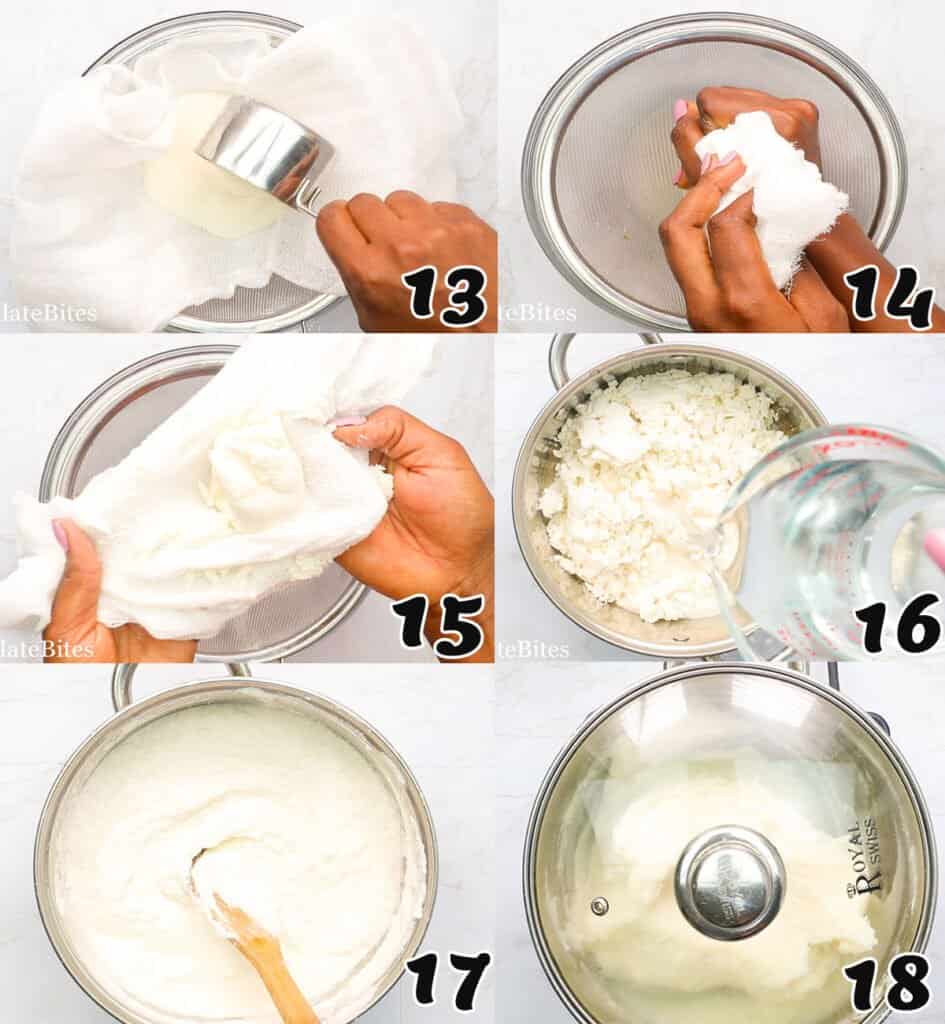
Cook the Fufu
- Squeeze the Excess Water – Using cheesecloth, squeeze the water from the cassava puree; this helps storage. (Photos 10-15)
- Wrap and Freeze – Wrap in portions and freeze until ready to use—thaw before cooking.
- Stir and Cook – Place the desired amount of fufu in a saucepan on medium heat. Add a little bit of hot water as needed. Keep stirring vigorously until cooked through. This takes about 10-15 minutes, depending on the quantity. (Photos 16-21)
- Shape and Wrap – Then, shape them into round or ovals and wrap them with thin plastic. (Photos 22-24)
Recipe Variations
- Lemon – If you find cassava fufu too bland for your taste, you can add a teaspoon of lemon or lime juice to brighten up the flavor.
- Plantain – You can use plantain flour mixed with the ground cassava for a different twist.
- Seasonings – You can’t go wrong with salt and pepper. These two seasonings are enough to enhance the flavor of our fufu, especially if you want to eat them on their own.
- Sweet Potato Fufu – This one is more flavorful than cassava fufu because sweet potatoes are naturally sweet. A dash of cinnamon and cardamom also amplifies the flavor. Oh yes!
- Corn Fufu – Like sweet potatoes, corn is also naturally sweet and tasty. So, if you love corn, then you’ll surely gonna love this corn fufu made with cornmeal as well.
Tips and Tricks
- You don’t need to add flavor to our fufu since it is meant to be eaten with stew or soup, just like how we enjoy rice as a side with the main dish.
- Add 1-2 teaspoons of baking soda to aid in the fermentation process.
- You may use a little bit of lime juice to add acidity to your fufu while blending.
- Fermentation is best in a warm area as it will take longer in cool weather.
Serving and Storage Instructions
This is how you eat cassava fufu: Get a small portion of fufu and shape it with your hand and slightly make an indentation with your thumb. Then use it to scoop your favorite stew or soup like a spoon. Pretty neat, huh? 😉
Due to the long fermentation process of cassava, it’s best to make a big batch and prepare them ahead to save you time and effort for future cravings. Oh yes!
Storing Yuca
- Unpeeled – Store your cassava in a dry, cool area, and it will last at room temperature for up to a week and two weeks in the fridge.
- Peeled and Cut – Place them in a bowl covered with water, changing the water daily to keep it fresh in the fridge for up to a month. If you plan on freezing the yuca, there’s no need to soak them after peeling and cutting. Your yuca will last up to three months in a freezer-safe bag in the freezer.
- Processed or Ground – Squeeze as much liquid as possible in cheesecloth before storing raw blended cassava. You can keep raw fufu in an airtight container or freezer-safe resealable bag in the refrigerator for a few days or three months in the freezer.
Storing Leftover Fufu
- Wrap leftovers tightly with a cling wrap to keep them moist.
- Keep leftover fufu in the fridge for up to five days and three months in the freezer.
- Thaw it overnight in the fridge when ready to serve, then set it on the counter for around an hour so that it comes to room temperature before reheating.
Reheating Leftover Fufu
- Oven – Cut the leftover fufu into bite-size pieces and lay them in a single layer on a baking sheet, uncovered. Bake at 350℉/177℃ for 10 minutes or until warmed through.
- Stovetop – Use a steamer and add enough water to steam your water fufu. Steam the fufu until it’s soft and warm.
- Microwave – Microwave the foofoo in 10-second blasts for 30 seconds to a minute or until heated through.
FAQs
It really depends on the ingredients in your fufu and how it was prepared. And since we don’t usually add seasonings, it’s somewhat bland if eaten alone. It may also taste slightly sour because of the fermentation. But this I assure you, pair them with any savory and rich stew or soup, and you’ll be amazed how heavenly our fufu is. 😉
Absolutely! Cassava is an excellent source of healthy carbs, essential for energy. It’s also full of vitamins and minerals, especially vitamin C, potassium, thiamine, riboflavin, and niacin, great for our immune system.
Fufu becomes soft and sticky after you cook it. The water activates the starch, making it sticky. If you find it too sticky or too thick and hard to work with, just add a smidgin of water and continue mixing. The texture should be smooth and soft enough to easily shape it into a ball, and it will firm up once cooled.
What to Serve with Cassava Fufu
The best way to enjoy this healthy fufu is by pairing them with any traditional African soup, such as these rich and flavorful soups and stews below.
More Cassava Recipes to Try
Watch How to Make It
[adthrive-in-post-video-player video-id=”t029pziM” upload-date=”2020-01-22T13:50:08.000Z” name=”Cassava Fufu/Water Fufu” description=”Homemade Cassava FuFu /Water FuFu – a staple food in many African countries that is made from fermented and grounded starchy cassava roots and is a great side dish to any protein-rich food.” player-type=”default” override-embed=”default”]
This blog post was first published in September 2014 and has been updated with an additional write-up, new photos, and a video.
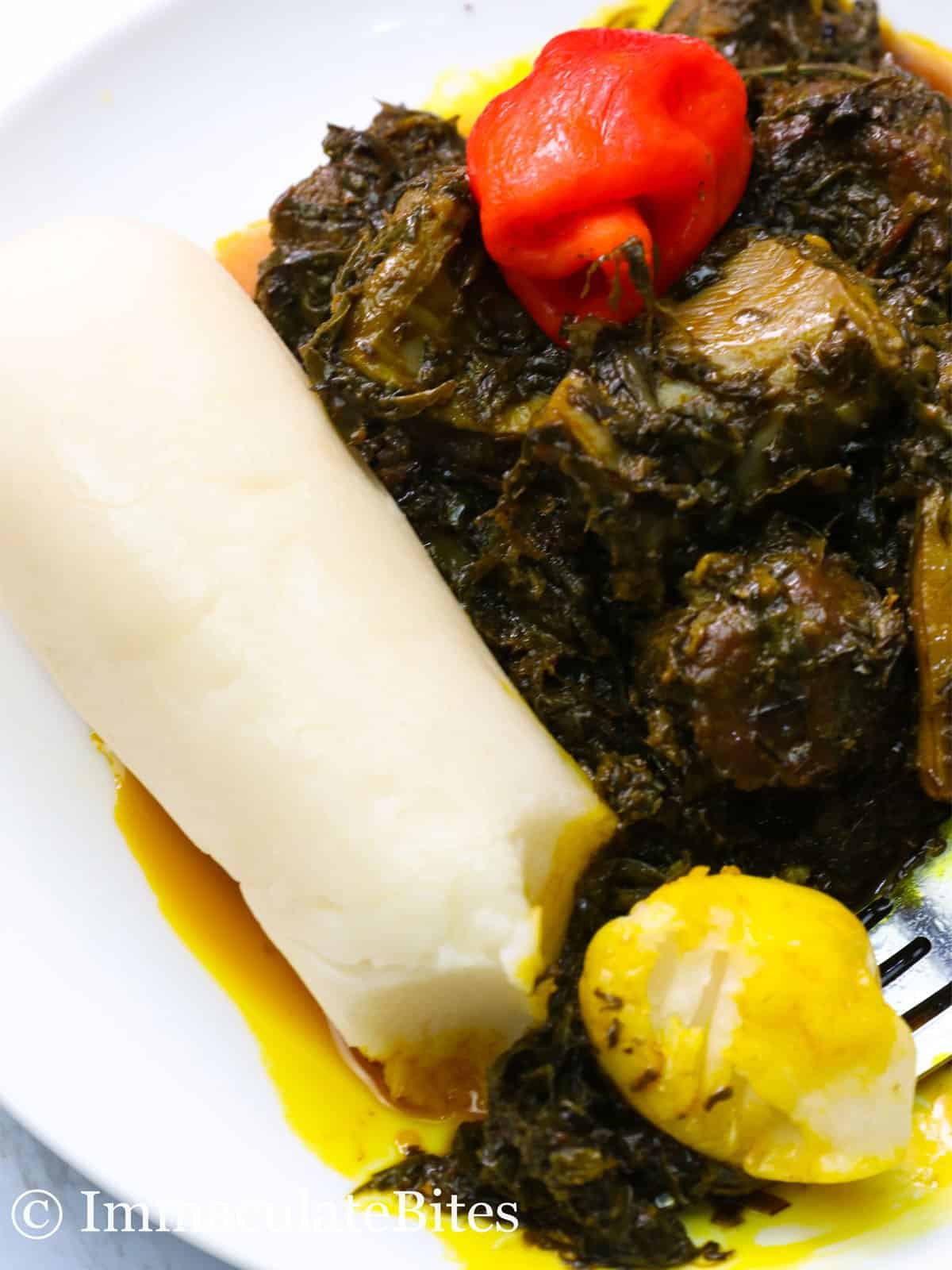
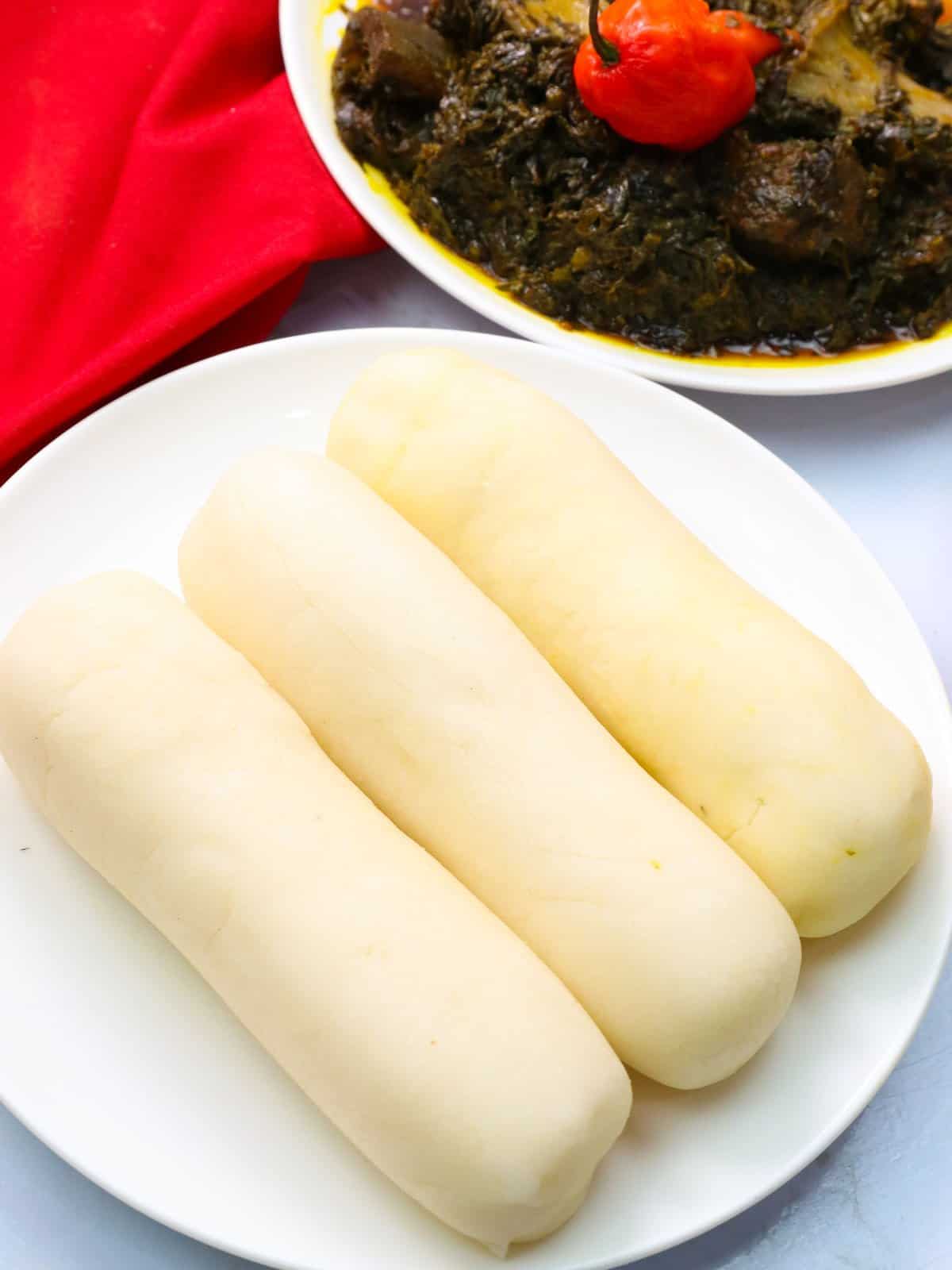
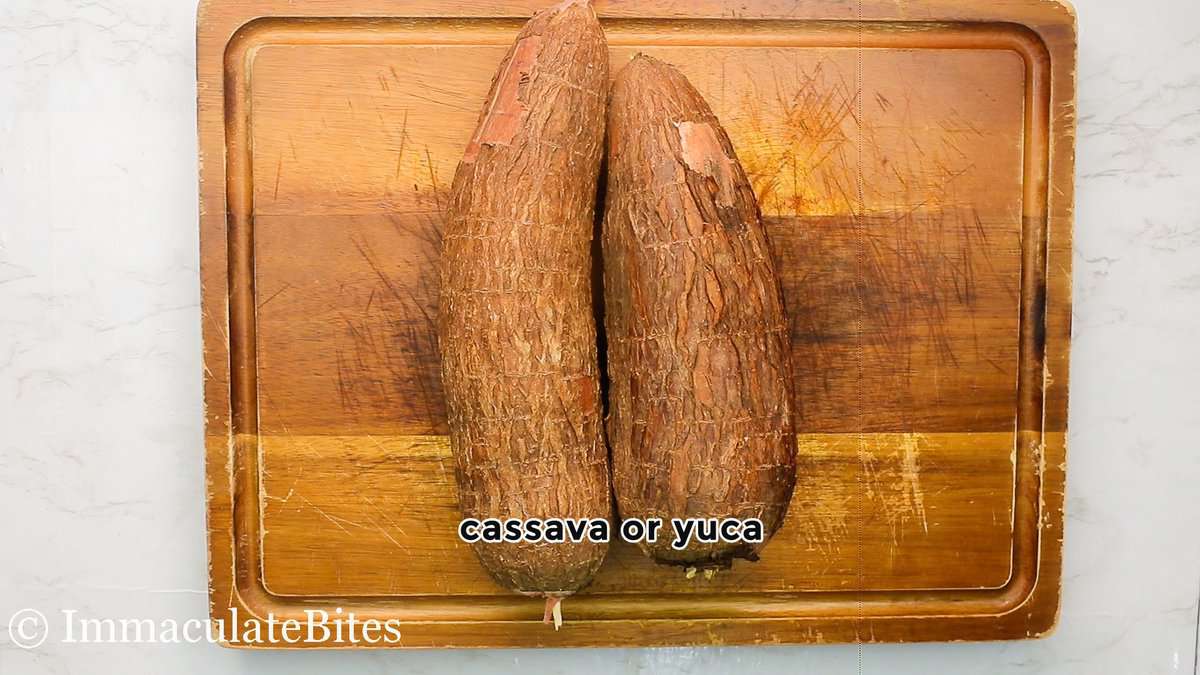
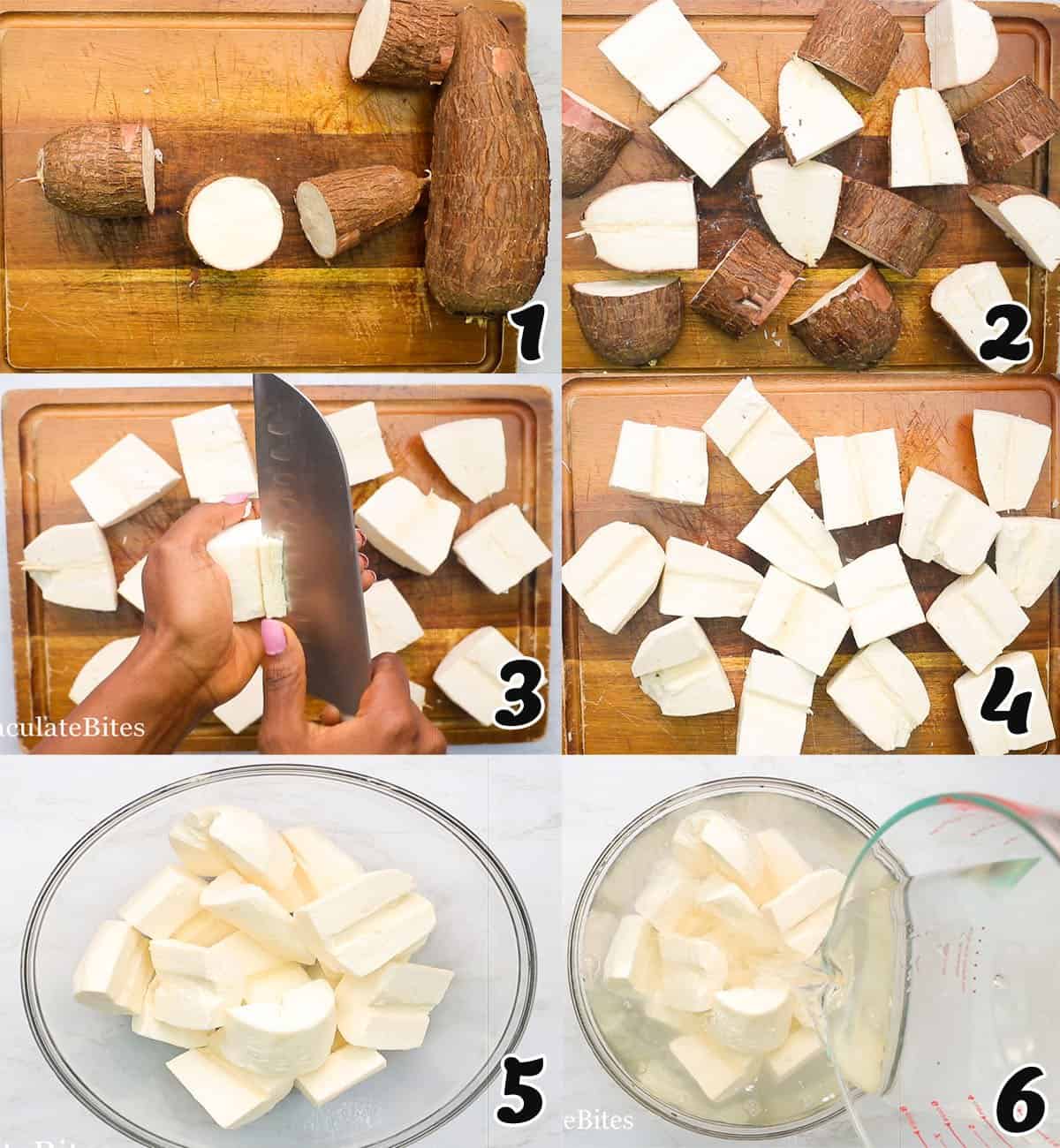
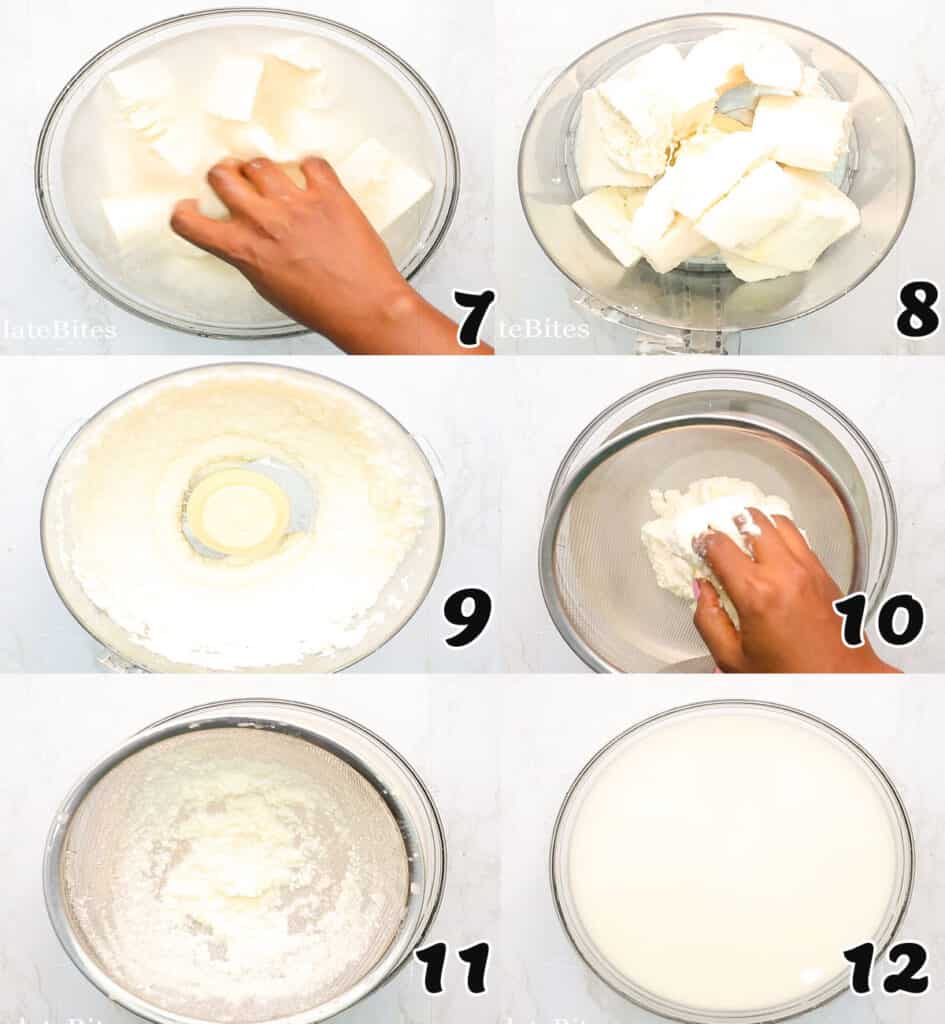
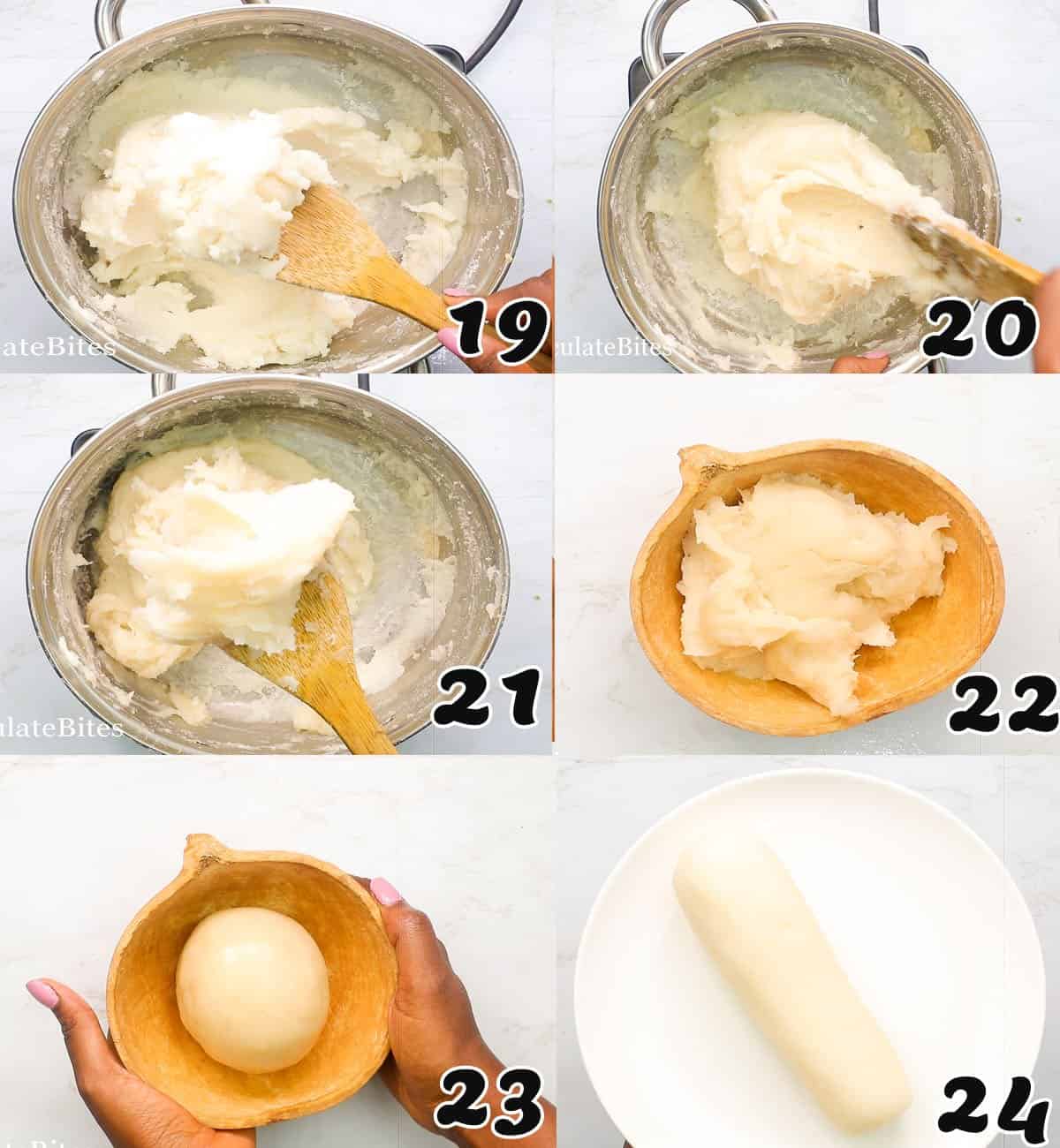
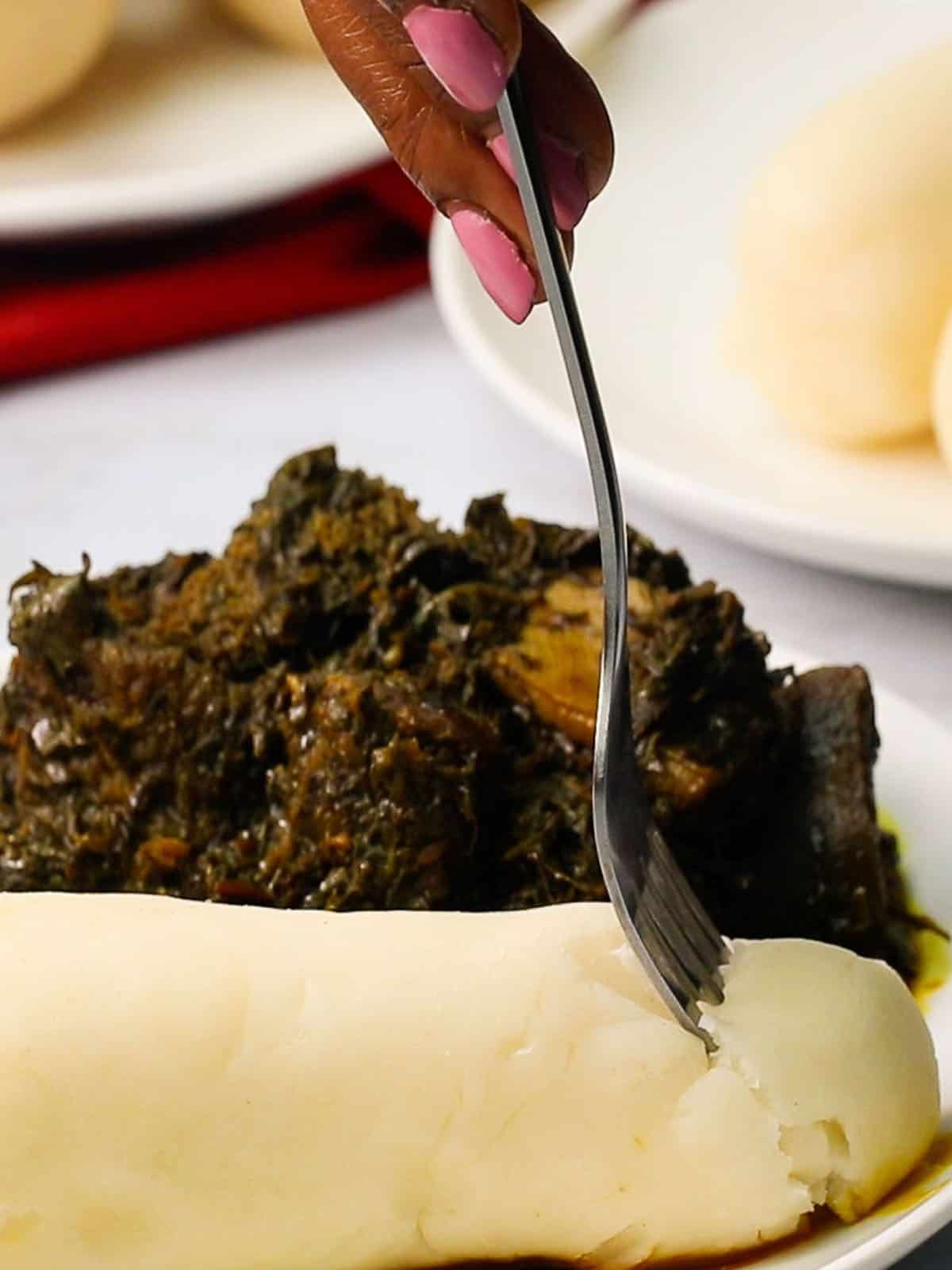
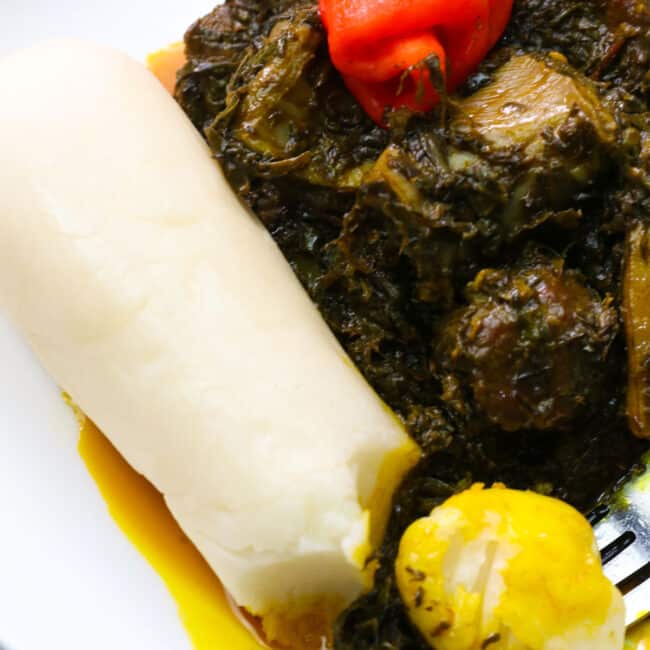

Gahunwande Elizabeth says
Hello good morning. Thanks for your lecture on how to soak and cook fufu. I have tried to do same long ago even now but my challenge is that after like five days or a week, the cassava is always strong as fresh. Please what should I do further.
Imma says
I have that issue previously, as you know Casav has different variety. So you can shred it and saok it this way it might helps you. Let me know how it turns out for you 🙂
Pat G says
I haven’t eaten this in many years so I am glad for the reminder. Thank you!
Adeniran shina says
Pls as Fufu supplyer for consumption what can you use to preserved it for a longer period of days ?
Immaculate Bites says
Hello Adeniran! You can preserve Fufu by wrapping it tightly or putting it in an airtight container and then freeze it or keep it in the refrigerator for 5 days. Please make sure that it has cooled down before wrapping it to prevent moisture which can cause spoilage.
John Doe says
It worked perfectly
ImmaculateBites says
Thanks for the feedback!
Michaela Johnson says
I made but I was scared to eat it since it’s a poison root I wasn’t sure if I cooked it long enough to insure it was eatable
ImmaculateBites says
Soaking and thoroughly cooking the cassava makes it less scary to eat.
JB says
I grew up in Suriname, South America. Mother prepared this most delicious dish on special occasions, served with okra stew. She used regular cassava. Don’t worry about toxic cassava if you’re living here in the U.S. because you can’t find it here. For traditional cassava dishes I use commercially available cassava from the Caribbean (at times frozen) Thanks for the recipe, I can’t wait to try it and surprise my siblings.
Immaculate Bites says
Thank you, JB! And what a thoughtful surprise for your siblings. I’m touched knowing that my recipes will somehow be a part of such a lovely gesture <3
Ben ken says
This is not the Africa way of making fufu
Pat G says
So long as you brought the water to the boil for at least 10 minutes the heat should kill any toxins. Also, please note that only bitter cassava is poisonous and most of the cassava we get in North America etc is sweet cassava which is not poisonous at all so that one should never be a problem.
David says
This piece on fufu will not only make you salivate but as well open one up to the business opportunities here
ImmaculateBites says
Great! Glad you loved it, David!
Ivory says
Mine has been 6days and no fermentation yet despite using baking soda. What do I do pls.
ImmaculateBites says
Hi Ivory. I am so you are having trouble with your cassava fufu. In order to speed up the fermentation, I suggest you chop up the cassava into tiny bits and soak in freshwater. Next, find the warmest area in your house and leave it there covered. I hope this helps. Do let me know how this works for you.
Balikis says
Hello,am a nigerian living in south africa.pls help me out with this cause have soaked my cassava for more than a week now still it’s not soft yet nd I don’t have a strong blender to blend it.pls is there any other way I can go about…don’t know May be because we are in winter that’s why it’s not soft through fermentation…any other ways I can go about it?
ImmaculateBites says
Hi Balikis. Sorry you are having trouble with your cassava. The cold weather is definitely preventing it from fermenting the way it should. What you could do is, chop up the cassava into tiny bits and soak in fresh water. Next find the warmest area in your house and leave it there covered. You could also leave it in your oven as it turns to be warm giving all the cooking going on on your stove. I hope this helps. Do let me know how this works for you.
Ben ken says
It may take 2 weeks it’s depends of your weather, try to seal it up put it in the warm part of your house
Darja says
Hello,
I’m doing okra soup and wanted to make cassava fufu for my husband birthday this Sunday, and I did not check the recipe out before I bought the cassava and now see it’s has to ferment for 3-5 days and I only got 2 days so what’s your advise? Can you still make it with only 2 days fermentation? Or Can I cook the cassava to soften it? Is this impossible should I just try to make fufu out of corn or something? Please help me out
Kind regards
Darja
ImmaculateBites says
Hi Darja. What you could do is, chop the cassava into very small pieces. Then, if you have a strong blender, blend it. Keep this in a warm area for as long as possible. You can even place this under the sun. This should hasten the fermentation process. When you are ready to cook, blend again, and proceed with the rest of the instructions. Let me know how it works for you.
Dollarbill says
Please how can someone have a white fufu at the end of cooking it. Is there any whitener apply?
ImmaculateBites says
No there is no whitener applied . It all depends on your cassava.
Killian Kaila says
Hello,
May I know. If you want to prepare Fufu according to your instructions, can you add a bit of maize meal? If yes, at what stage during the preparation process?
ImmaculateBites says
Hello Kaila,
I haven’t tried making both together. Corn maize takes a longer time to cook. So it wouldn’t be ideal to make both at the same time.
LYNDA ARHIN says
Once you add maize meal, it’s changes the texture – it makes it firmer like what the Ghanaians call banku.
Note: To make banku softer and smooth, we add cassava dough.
I hope this helps.
Lynda
ImmaculateBites says
Nice! Thanks for sharing Lynda.
Sebastian says
I am ordering a food processor with the hopes of making this and the Haitian malanga accra.
Is this similar to the Congolese kenke? I believe they grate fermented cassava and then wrap in leaves and boil several hours.
Do you have a recipe for Nigerian buka stew?
How about guyanese pepperpot. Do you know a good brand on amazon for cassareep
ImmaculateBites says
Yes it is very similar. No I don’t have a recipe for Nigerian buka stew yet or guyanese pepperpot .For the most part I buy all my West Indian condiments from an international market or Caribbean Market. It’s more authentic. Look for one around you.
Fanta says
In Guinea, the Jahankas call it tu the Fulanis say fufu
Are you Susu or any African tribe? Just wondering.
ImmaculateBites says
Yes, I am . From Cameroon.
Charla Gotier says
If I am using cassava flour, what would your instructions be? Just mix with water until desired consistency? I’ve never made fufu…sorry if silly ?!
ImmaculateBites says
Not silly at all, that’s the way to do it.
Toni McAndrew says
Hi Imma,
I was just wondering whether you have any advice. I would like to start fermenting cassava, mainly for the probiotic properties. When you heat up fermented cassava does this kill the bacteria? Is it safe to consume fermented cassava uncooked?
I am struggling to find the answer online, and I haven’t yet cooked with cassava so I am not very confident.
Thanks for the article and recipe, it sounds interesting and I am looking forward to experimenting!
Toni
ImmaculateBites says
Hi Toni! Am sorry I don’t have mush to share on this . Hope you do find what you are looking for .
Renae says
Hi Tony did you find an answer about the probiotics? I’m also interested in consuming it for the high level of probiotic bacteria. Cheers
Lili says
HeI. Is water just enough for fermentation? What about temperature? Thanks
ImmaculateBites says
Yes and to keep it from getting spoiled . It works best in high temperature – especially during summer.
Lance Lokas says
Hey Imma thank you so much for this recipe. I’ve been looking for a fufu recipe that is from scratch using cassava. I did have a question though. Cassava can be fatally poisonous if not prepared in the correct way. How do I make sure that the cassava fufu is safe to eat?
ImmaculateBites says
Hi Lance ! If you live in the USA you do not have to worry about cyanide laced cassava . There are strict regulation in place with little threat to those who eat it.
Mallion says
I live in Hawai’i and grow my own that I am using in your recipe. Does that still apply? Does the fermentation really get rid of it? My plan was to try and combine your recipe with a Filipino recipe called Budbud where I will mix with some coconut milk and honey, wrap it in banana leaf and steam. yep.
ImmaculateBites says
Hi, I was just in Hawaii a couple of days ago and tried some cassava. It tasted the same to me. If you mean cyanide, then there is no need to worry. There are strict regulation in place with little threat to those who eat it.
P.s the recipe sounds delicious!!!
Uje says
Hey Imma, what if you live in Nigeria where there are no rules regarding the Cassava how do I know it’s safe for consumption?
Immaculate Bites says
Hi Uje! I think I have answered a somewhat similar problem from another reader who is also from Nigeria. You may scroll down and look for the comment from “Balikis”, maybe s/he can also help. Let me know how it goes! 🙂
Joan says
For over 2weeks that I soak my casava its yet to be fermented what do I do
ImmaculateBites says
Oh No! That is just way too long. Has it been outside throughout this period ? It must be the cassava or lack of humidity/ heat from the sun. Truth be said, a lot cassava nowadays if you reside abroad have been altered . They don’t just come out right. I usually ground after 3 days, then give it a day or two .